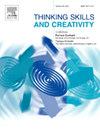小学教师对批判性思维的认知及其教学
IF 4.5
2区 教育学
Q1 Social Sciences
引用次数: 0
摘要
批判性思维(CT)是国际教育的一个重要目标,它使人们能够驾驭不断增长的信息量,并在日益复杂的问题上做出明智的决定。“CT”一词经常出现在教育政策文件和课程中,教师在提供有效的CT教学中起着关键作用。研究表明,尽管教师认识到CT的重要性,但许多教师缺乏对CT真正含义的理解,并且对教授CT感到措手不及。需要进一步的研究来获得对小学CT的更深入的理解。由于教师倾向于根据他们对CT的认知进行教学,因此了解教师如何理解CT是很重要的。本探索性质的研究调查了一组挪威小学教师(n = 56)如何看待CT的概念,无论是在一般情况下还是在教学中。通过对反思笔记(n = 56)和半结构化小组访谈(n = 15)的反身性专题分析,我们发现技能比性格更受重视。教师对CT的看法主要是技能倾向,对其社会维度的关注有限。性格似乎被排除在他们关于CT与教学的观点之外,这被认为是有问题的,因为性格可以被视为CT的驱动力。从我们研究的教育意义来看,我们可以得出结论,教师需要专业发展,以意识到教学倾向和技能的必要性,并使他们包括CT的社会方面。本文章由计算机程序翻译,如有差异,请以英文原文为准。
Primary school teachers’ perceptions of critical thinking in general and in their teaching
Critical thinking (CT) is a key education goal internationally, and enables people to navigate the growing amount of information and make informed decisions on increasingly complex issues. The term CT is frequently used in educational policy documents and curricula, and teachers play a key role in delivering effective CT instruction. Studies indicate that although teachers recognize the importance of CT, many lack an understanding of what CT really means, and feel unprepared to teach CT. Further research is needed to obtain a deeper understanding of what CT in primary school implies. As teachers tend to teach in accordance with their perception of CT, it is important to gain an insight into how teachers understand CT. This exploratory qualitative study investigates how a group of Norwegian primary school teachers (n = 56) perceive the concept of CT, both in general and in their teaching. Using reflexive thematic analysis of reflection notes (n = 56) and semi-structured group interviews (n = 15), we found that skills are emphasized more than dispositions. Teachers primarily have a skills-disposition view of CT, with limited attention to its social dimensions. Dispositions seem to be excluded from their views of CT in relation to teaching, which is considered problematic, as dispositions can be seen as the driving force for CT. As an educational implication of our study, we can conclude that there is a need for professional development for teachers to be aware of the necessity of teaching dispositions as well as skills, and for them to include the social aspects of CT.
求助全文
通过发布文献求助,成功后即可免费获取论文全文。
去求助
来源期刊

Thinking Skills and Creativity
EDUCATION & EDUCATIONAL RESEARCH-
CiteScore
6.40
自引率
16.20%
发文量
172
审稿时长
76 days
期刊介绍:
Thinking Skills and Creativity is a new journal providing a peer-reviewed forum for communication and debate for the community of researchers interested in teaching for thinking and creativity. Papers may represent a variety of theoretical perspectives and methodological approaches and may relate to any age level in a diversity of settings: formal and informal, education and work-based.
 求助内容:
求助内容: 应助结果提醒方式:
应助结果提醒方式:


